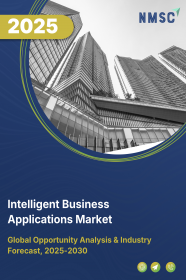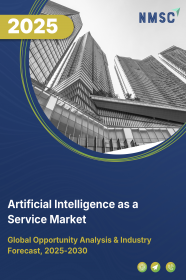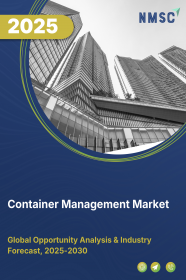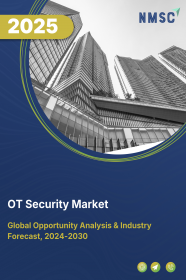
Intelligent Business Applications Market by Type (Software and Services (Consulting & Advisory, Installation, and Support & Maintenance)), by Deployment Mode (On-Premises and Cloud-based), by Application (Data Management, Analytics and Reporting, Process Automation, and Others), by Enterprise Size (Large Enterprises and Small and Medium Enterprises (SMEs)), and by End-Users – Global Opportunity Analysis and Industry Forecast, 2025-2030
US Tariff Impact on Intelligent Business Applications Market
Trump Tariffs Are Reshaping Global Business
Intelligent Business Applications Market Overview
The global Intelligent Business Applications (IBA) Market size was valued at USD XX billion in 2024 and is predicted to reach USD XX billion by 2030 with a CAGR of XX% from 2025 to 2030.
The market is driven by the rapid adoption of cloud-based solutions, enhanced operational efficiency, and advancements in AI and machine learning, which optimize workflows and improve decision-making.
However, data privacy and security concerns limit market growth, requiring strong protective measures. Key opportunity lies in AI-powered augmentation and copilots, such as Microsoft’s Copilot and Amazon Q, which boost human productivity and decision-making, fostering innovation and market expansion.
Rapid Adoption of Cloud-Based Solutions Fuels Market Expansion
The shift toward cloud-based intelligent business applications is a significant driver, offering scalability, flexibility, and cost-effectiveness. Cloud platforms like Microsoft Azure, AWS, and Oracle Cloud enable seamless deployment of AI-driven applications, reducing infrastructure costs and enabling real-time data access.
For example, SAP’s S/4HANA Cloud, which saw a 32% revenue growth in Q1 2024, provides SMEs with affordable, cloud-native ERP solutions. Microsoft’s 2025 release wave 1 for Dynamics 365, announced in January 2025, further enhances cloud-based automation, with features like AI-driven tax management for Dynamics 365 Finance.
Improved Operational Efficiency Driving the Market Growth
Businesses across various sectors are increasingly adopting intelligent business applications to streamline their operations and enhance efficiency. These applications leverage AI to automate repetitive tasks, optimize workflows, and improve resource management. In manufacturing, for example, IBA are used for predictive maintenance, identifying potential equipment failures before they occur, thus minimizing downtime and reducing costs.
Intelligent applications also optimize supply chain management by predicting demand fluctuations and automating procurement processes. The promise of significant cost savings and increased productivity makes improved operational efficiency a key driver for the adoption and market share growth of IBA.
AI and Machine Learning Advancements Driving the Market Expansion
Advancements in AI and machine learning are propelling the intelligent business applications market demand by enabling smarter, more adaptive solutions. Technologies like generative AI and natural language processing (NLP) allow applications to analyze vast datasets, predict trends, and deliver actionable insights.
Oracle’s Fusion Cloud ERP, enhanced with AI-powered tools launched in September 2024, can automates financial planning and procurement, improving accuracy by 30% for clients like large-scale retailers.
Similarly, Microsoft’s Copilot Studio, updated in November 2024, supports autonomous agents that handle complex tasks like supply chain optimization, with companies like Schneider Electric reporting a 94% reduction in sales data research time. These innovations drive the market’s growth potential, as businesses seek scalable, intelligent tools to stay competitive.
Data Privacy and Security Concerns Restraining Market Growth
The benefits of AI-powered intelligent business applications are numerous, concerns surrounding data privacy and security present a significant restraint to their widespread adoption. These applications handle sensitive business and customer data, and ensuring its confidentiality, integrity, and availability is paramount.
The increasing complexity of data privacy regulations and the potential for data breaches necessitate robust security measures and compliance frameworks. Addressing these concerns and building trust in the security of intelligent applications is crucial for overcoming this restraint and realizing the full growth potential of the IBA market expansion.
Integration of AI-Powered Co-Pilot Creates Future Market Opportunities
A significant opportunity for industry players in the intelligent business applications market lies in the development and deployment of AI-powered augmentation and copilots. These intelligent assistants are designed to work alongside human users, enhancing their capabilities and productivity rather than replacing them entirely.
Microsoft's Copilot, integrated into its Dynamics 365 and Power Platform, exemplifies this trend by providing AI-powered assistance for tasks like content creation, data analysis, and workflow automation.
Similarly, Amazon Q in QuickSight offers AI-powered data analysis and visualization capabilities. This focus on augmenting human intelligence with AI offers immense potential to improve decision-making speed, enhance creativity, and boost overall workforce efficiency, representing a major avenue for innovation and market share expansion within the industry. For instance, Microsoft launched Researcher and Analyst agents for Microsoft 365 Copilot on March 25, 2025, enhancing data analysis and research capabilities within enterprise workflows.
Market Segmentations and Scope of the Study
The intelligent business applications market report is segmented based on type, deployment mode, application, enterprise size, end-user, and region. By type, the market is categorized into software and services. Services are further segmented into consulting & advisory, installation, and support & maintenance. Based on deployment mode, it is classified into on-premises and cloud-based solutions. On the basis of application, the market is segmented into data management, analytics and reporting, process automation, customer engagement, financial performance and strategy management, and others. By enterprise size, the market includes large enterprises and small and medium enterprises (SMEs). Based on end-user industry, the market is divided into banking, financial services, and insurance (BFSI), healthcare and life sciences, IT and telecom, retail and e-commerce, government and defense, energy and utilities, transportation and logistics, and others. Regional breakdown and analysis of each of the aforesaid segments include regions comprising North America, Europe, Asia-Pacific, and RoW.
Geographical Analysis
North America dominates the intelligent business applications market share, due to its robust technological ecosystem and high adoption of AI-driven solutions. The United States, in particular, leads with companies like Microsoft and IBM driving innovation. Microsoft’s Dynamics 365, enhanced with Copilot capabilities launched in October 2024, has streamlined operations for enterprises like Coca-Cola, boosting efficiency by 25%.
Europe holds a major share in the market, driven by a strong emphasis on data privacy and sustainability. The region’s stringent regulations, like GDPR, have pushed companies like SAP to enhance platforms such as S/4HANA Cloud, which saw an increase in 2024 among European firms for compliant financial reporting.
Germany and the UK lead, with initiatives like Microsoft’s 2025 Release Wave 1 for Dynamics 365, thus introducing AI-driven tax management which enhances compliance accuracy, and minimizes audit risks for enterprises. This strategic shift is driving the growth of the market, as companies across these countries increasingly adopting AI-powered ERP and CRM systems to streamline operations, reduce costs, and improve decision-making efficiency.
Europe’s focus on green technology also fuels demand for sustainability-focused applications, such as Oracle’s Fusion Cloud Sustainability, used by retailers like H&M to reduce emissions by 10%. Despite these advancements, high implementation costs and complex regulatory landscapes pose challenges, potentially slowing market expansion.
Asia-Pacific is the fastest-growing region in the intelligent business applications sector, driven by rapid digital transformation and increasing AI adoption. Oracle’s Fusion Cloud ERP, launched with AI enhancements in September 2024, has gained a 32% adoption rate among SMEs in China, optimizing supply chain processes.
The region’s growth potential is bolstered by government initiatives, such as China’s “Digital China” strategy, but challenges like inconsistent infrastructure and skill gaps in smaller markets could hinder progress. Asia-Pacific’s rising market share reflects its pivotal role in shaping global industry trends.
The Rest of the World, including Latin America, the Middle East, and Africa, is witnessing growth in the intelligent business applications market, driven by increased investments in AI-driven ERP systems and cloud infrastructure.
In Latin America, Brazil leads with adoption of Microsoft Dynamics 365 for financial management in 2024. In the Middle East, UAE firms are using Oracle’s Fusion Cloud for retail analytics. However, challenges like infrastructural limitations and economic volatility, particularly in Africa where cloud penetration remains low, pose significant obstacles.
Analysis of Strategic Innovation and Positioning Adopted by Key Players
The leading players in the global IBA industry, striving for increased market share and capitalizing on the significant growth potential of this expanding market size, are strategically focusing on the deep integration of artificial intelligence (AI) and machine learning (ML) across their offerings.
For instance, Microsoft is heavily investing in its Copilot capabilities within Dynamics 365 and the Power Platform, aiming to provide AI-powered assistance for a wide range of business tasks, empowering both technical and citizen developers.
Similarly, Oracle has announced intelligent applications and new AI-powered features for its Fusion Data Intelligence suite. Amazon is also making strides with Amazon Q in QuickSight, focusing on revolutionizing business intelligence (BI) through powerful AI-driven data analysis. These developments underscore a key market trend towards AI augmentation, offering users intelligent assistance within their workflows.
A challenge these players face, though not explicitly detailed in these sources but evident in the broader technology landscape, lies in ensuring seamless integration of these advanced intelligent applications with existing, complex, legacy systems.
However, the opportunity lies in developing more industry-specific intelligent applications that address the unique challenges and requirements of particular sectors, such as Microsoft's focus on transforming manufacturing with intelligent applications, or C3 AI's introduction of an Asset Performance Suite for intelligent operations.
Furthermore, the rise of low-code/no-code platforms, exemplified by Microsoft's Power Apps, presents an opportunity to democratize the creation of intelligent applications, expanding their reach and further driving market growth.
Key Benefits
-
The report provides quantitative analysis and estimations of the industry from 2025 to 2030, which assists in identifying the prevailing intelligent business applications market opportunities.
-
The study comprises a deep-dive analysis of the current and future intelligent business applications industry trends to depict prevalent investment pockets in the sector.
-
Information related to key drivers, restraints, and opportunities and their impact on the industry is provided in the report.
-
Competitive analysis of the players, along with their market share is provided in the report.
-
SWOT analysis and Porters Five Forces model is elaborated in the study.
-
Value chain analysis in the market study provides a clear picture of roles of stakeholders.
Intelligent Business Applications Market Key Segments
By Type
-
Software
-
Services
-
Consulting & Advisory
-
Installation
-
Support & Maintenance
-
By Deployment Mode
-
On-Premises
-
Cloud-based
By Application
-
Data Management
-
Analytics and Reporting
-
Process Automation
-
Customer Engagement
-
Financial Performance and Strategy Management
-
Others
By Enterprise Size
-
Large Enterprises
-
Small and Medium Enterprises (SMEs)
By End-User Industry
-
Banking, Financial Services, and Insurance (BFSI)
-
Healthcare and Life Sciences
-
IT and Telecom
-
Retail and E-commerce
-
Government and Defense
-
Energy and Utilities
-
Transportation and Logistics
-
Others
By Region
-
North America
-
The U.S.
-
Canada
-
Mexico
-
-
Europe
-
The UK
-
Germany
-
France
-
Italy
-
Spain
-
Denmark
-
Netherlands
-
Finland
-
Sweden
-
Norway
-
Russia
-
Rest of Europe
-
-
Asia Pacific
-
China
-
Japan
-
India
-
South Korea
-
Australia
-
Indonesia
-
Singapore
-
Taiwan
-
Thailand
-
Rest of Asia Pacific
-
-
RoW
-
Latin America
-
Middle East
-
Africa
-
Key Players
-
Avanade Inc.
-
Saxon AI
-
Infosys Limited
-
Sisense Ltd.
-
UiPath
-
Oracle Corporation
-
Microsoft Corporation
-
International Business Machines Corporation (IBM)
-
SAP SE
-
Amazon Web Services, Inc.
-
Salesforce, Inc.
-
Adobe Inc.
-
Tableau Software, LLC
-
SAS Institute Inc.
-
Infor
REPORT SCOPE AND SEGMENTATION:
|
Parameters |
Details |
|
Market Size in 2024 |
USD XX Billion |
|
Revenue Forecast in 2030 |
USD XX Billion |
|
Growth Rate |
CAGR of XX% from 2025 to 2030 |
|
Analysis Period |
2024–2030 |
|
Base Year Considered |
2024 |
|
Forecast Period |
2025–2030 |
|
Market Size Estimation |
Billion (USD) |
|
Growth Factors |
|
|
Countries Covered |
28 |
|
Companies Profiled |
15 |
|
Market Share |
Available for 10 companies |
|
Customization Scope |
Free customization (equivalent up to 80 working hours of analysts) after purchase. Addition or alteration to country, regional, and segment scope. |
|
Pricing and Purchase Options |
Avail customized purchase options to meet your exact research needs. |

















 Speak to Our Analyst
Speak to Our Analyst




















